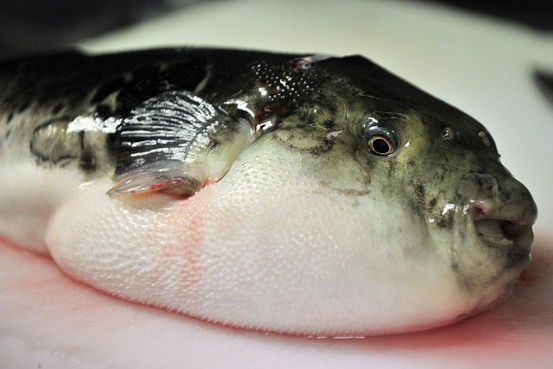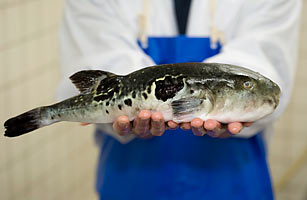
Takifugu rubripes
FAMILY
Tetraodontidae
TAXONOMY
Takifugu rubripes Temminck and Schlegel, 1850, “Coasts of Japan.”
OTHER COMMON NAMES
Japanese: Torafugu (tiger fugu).
PHYSICAL CHARACTERISTICS
Body oblong, compressed, and covered with prickles. Color is
dark gray or grayish olive dorsally and white ventrally. A large
black spot, ringed in white, is positioned on the flank just behind
the pectoral fin. The dorsal fin has 16–19 soft rays, and
the anal fin has 13–16 soft rays. The caudal fin is truncate.
Poisonous, especially the ovaries, liver, and intestines. Grows
to 27.6 in (70 cm) in total length.
DISTRIBUTION
Temperate waters of the northwest Pacific from the East
China Sea and the Yellow Sea to the Sea of Japan as far north
as Hokkaido.
HABITAT
Rocky reefs and shingle flats, usually up in the water column.
Also frequents inlets and brackish waters but moves offshore
with age and growth. Depth range is 3.3–656 ft (1–200 m).
BEHAVIOR
Solitary or in loose groups. This species swims about in the
water column.
FEEDING ECOLOGY AND DIET
Omnivorous, feeding mainly on invertebrates.
REPRODUCTIVE BIOLOGY
The breeding season runs typically from March to May.
Spawning is paired. Eggs are demersal and attached to rocks at
depths of less than 65.6 in (20 m). Larvae are pelagic.
CONSERVATION STATUS
Not listed by the IUCN.
SIGNIFICANCE TO HUMANS
Highly prized in commercial fisheries of Japan. May be taken
incidentally for aquaria. Also used in Chinese medicine.
Other popular Animals
Photo Gallery of - Fugu




 Animalia Life
Animalia Life